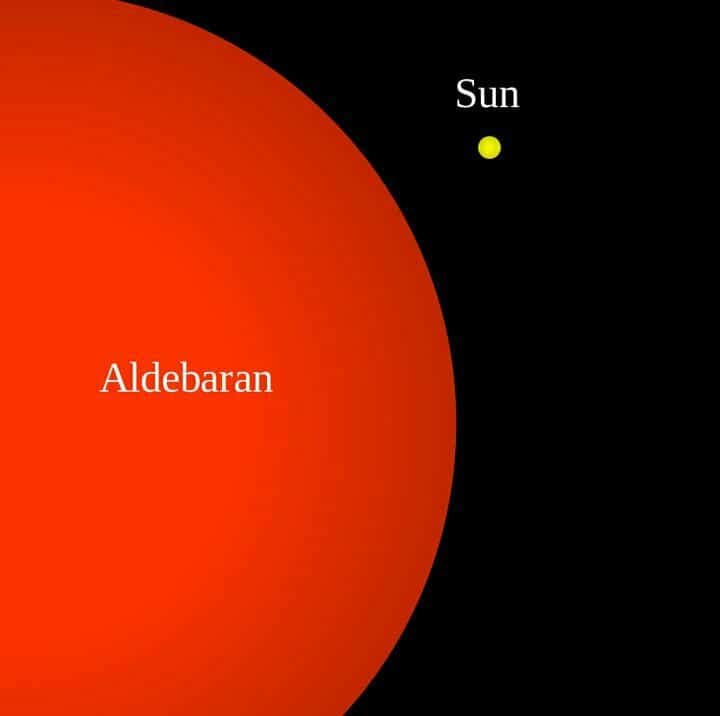
Stars are enormous celestial bodies composed of plasma that are held together by the force of gravity. As you might be aware, the Sun is the closest star to Earth and is located at the center of our solar system. With a diameter of approximately 1,392,684 kilometers, the Sun is relatively small when compared to numerous other stars that exist in the vast expanse of the universe. Many of these stars can be observed from our planet during the nighttime, appearing as individual points of light due to their immense distances. Throughout history, astronomers have classified the most renowned stars into constellations, while the brightest ones have been assigned unique names. Presented below is a compilation of the largest stars known to humankind, consisting of the top 10 rankings:
10. The star Sirius
The star Sirius, which is the most luminous star in the night sky, has an estimated age of 200-300 million years. It can be observed from almost anywhere on Earth and is located at a distance of approximately 8.6 light years from our planet. Sirius is approximately twice as massive as the Sun and shines 25 times brighter. It has a radius of 1.2 million kilometers, which is 71% larger than the radius of the Sun, and its surface temperature is around 9650ºC.
Observational data
(Epoch J2000.0)
The distance from Earth to Sirius is measured to be 8.60 ± 0.04 light years (2.64 ± 0.01 parsecs).
Visible stellar magnitude (V)
Physical characteristics
Temperature
An orange giant star located approximately 34 light-years away from Earth, Pollux is 9 times larger than the Sun and has a mass twice as heavy as our own star. With a radius of 5,564,000 kilometers, Pollux shines as the brightest star in the Gemini constellation. Its surface temperature measures around 4,600ºC.
Observational data
(J2000 era)
33.7 ± 0.3 sv years(10.34 ± 0.09 pc).
Apparent stellar magnitude (V)
Physical characteristics
Temperature
32 Solar luminosity
Metallicity
Arcturus, the brightest star in the Volopassus constellation, is a red giant star. It ranks as the fourth brightest star in the night sky, following Sirius, Canopus, and Alpha Centauri. The star is located approximately 36.8 light years away from Earth. Arcturus is significantly larger than the Sun, with a radius measuring around 17,870,000 kilometers. It boasts an age of approximately 7.1 billion years and maintains a surface temperature of about 4,000°C. As its supply of helium diminishes, Arcturus will eventually expand, shed its outer layer, and transform into a white dwarf within a planetary nebula.
Observational evidence
(Epoch J2000.0).
Approximately 36.7 ± 0.3 sv years (or 11.24 ± 0.09 pc).
Apparent stellar magnitude (V)
Physical characteristics
Temperature
210 ± 10 luminosities suns
Metallicity
7. The star Aldebaran
Aldebaran is a star of the orange giant type, located in the Taurus constellation at a distance of approximately 65 light-years. Aldebaran has a size that is about 44.2 times larger than the Sun, with a radius of about 30,740,000 km. Its surface temperature is estimated to be around 3,600°C. Aldebaran shines with a brightness that is 425 times greater than that of the Sun.
Observational data
(Epoch J2000.0)
Apparent stellar magnitude (V)
Physical characteristics
Temperature
150±10,00014 Sun’s luminosity
Metallicity
6.Star Rigel
Rigel, located in the constellation Orion, is the brightest star in the night sky and the seventh brightest overall. Its luminosity is approximately 12,000 times greater than that of the Sun. Rigel can be easily seen during winter evenings in the northern hemisphere and summer in the southern hemisphere. Its distance from Earth is around 860 light years. With a radius of about 54,250,000 km, Rigel is a staggering 78 times larger than the Sun. The surface temperature of this star is estimated to be around 10,750ºC.
Observational data
(Epoch J2000.0).
Apparent stellar magnitude (V)
Physical characteristics
Temperature
1.26+0.37
−0.29 × 10^5 luminosities suns
Metallicity
5. Star Antares
Antares, the brightest star in the constellation Scorpius, is 850 times larger than the Sun and 12 times more massive. If it were placed at the center of our solar system, it would be too big to fit within the orbit of Mars. Its distance from Earth is approximately 550 light years. It is also about 57,500 times brighter than the Sun. At around 12 million years old, it is nearing the end of its lifespan and is expected to undergo a supernova explosion within the next million years. In contrast, low-mass stars like our Sun have been in their main sequence for billions of years. Antares has a surface temperature of about 18225ºC.
Observational data
(Epoch J2000.0)
Apparent stellar magnitude (V)
Physical characteristics
Temperature
4. The star Betelgeuse
Betelgeuse, located in the constellation Orion, is a red supergiant and the ninth brightest star in the night sky (with Sirius being the brightest). It is situated approximately 640 light-years away from Earth and has a mass 20 times that of the Sun. With a radius of about 820,700,000 kilometers, Betelgeuse is currently in its red giant phase and is expected to reach the end of its life soon. Its radius is 1,200 times larger than that of our Sun, and it has a surface temperature of around 3325ºC.
Observational data
(Epoch J2000.0)
Apparent stellar magnitude (V)
Physical characteristics
With a mass of 1.531E31 kg, Betelgeuse is equivalent to 13-17 solar masses.
It also has a size that is 950 to 1200 times larger than the Sun.
Temperature
3. Mu Cepheus: The Enormous Red Supergiant Star
Mu Cepheus, located in the constellation Cepheus, stands out as one of the largest and most brilliant stars within the Milky Way galaxy. Its immense distance from Earth spans approximately 6,000 light years. With a mass equivalent to 20 times that of the Sun, Mu Cepheus remains an astronomical marvel. Its size dwarfs the Sun, as it measures a staggering 1,420 times larger in radius. The red supergiant star boasts a radius of 988,036,000 kilometers and a surface temperature of approximately 3,410º C. As Mu Cepheus nears the end of its life, it enters the final phase, which may result in a cataclysmic supernova explosion. In terms of brightness, this celestial giant outshines the Sun by a remarkable factor of 38,000.
Observational data
(J2000.0 era)
Visible stellar magnitude (V)
Physical characteristics
650 – 1420 radii Suns
Temperature
2. VV Cepheus: The Celestial Superstar
Situated in the constellation Cepheus, VV Cepheus, also known as HD 208816, is an awe-inspiring star that lies approximately 4,900 light-years away from our planet. With a scorching surface temperature of around 3,325º C, this celestial giant outshines most other stars in its vicinity. Its tremendous size is mind-boggling, boasting a radius estimated to be between 1,050 and 1,100 times larger than that of our Sun. To put it into perspective, the diameter of VV Cepheus measures a staggering 2,436,875,000 kilometers.
Observational data
(Epoch J2000.0)
Apparent stellar magnitude (V)
Physical characteristics
1. VY Big Dog star
VY of Big Dog is a red hypergiant located in the constellation of Canis Major. It holds the record for being the largest star in terms of size and is also one of the most luminous in its class. With a radius approximately 1540 times that of the Sun and a mass 25 times greater than our own star, VY Big Dog shines about 270,000 times brighter than the Sun. If it were placed within our solar system, it would extend all the way to the orbit of Saturn. This colossal star is located 4,900 light years away from Earth.
Observational data
(Epoch J2000.0)
Apparent stellar magnitude (V)
7.9607 (varies from 6.5 to 9.6)
Physical characteristics
1420 ± 120 radii Suns
Temperature
In recent times, these stars were considered the largest in the entire universe, however, scientific progress does not stand still. New stars have been observed that will easily surpass the top 10 largest stars that mankind has known so far. So, here are the contenders.
R136A1: The Most Massive and Brightest Star in the Universe
R136A1 is classified as a hypergiant and boasts a radius of approximately 24 million kilometers, which is around 35 times larger than our very own Sun. With an estimated mass of about 265 times that of the Sun, this star holds the title of being the most massive known star.
Not only is R136A1 incredibly massive, but it is also incredibly hot. Its surface temperature is estimated to be around 53,000 degrees Celsius, which is nearly 10 times hotter than the Sun. Additionally, it shines as the brightest star ever observed, radiating a luminosity nearly 9 million times greater than our Sun.
Westerlund 1-26 (W26)
W26, also known as Westerlund 1-26, is a red supergiant or red hypergiant located on the outskirts of the Westerlund 1 cluster. It is among the largest stars ever discovered. While scientists have not determined its exact radius, they estimate it to be between 1,530 – 2,550 times the size of our Sun, which corresponds to a volume between 3.6-16.6 billion times larger than the Sun. To put this into perspective, if W26 were placed at the center of our solar system, its photosphere would engulf the orbit of Saturn.
W26 is an incredibly bright star, ranging from 320,000 to 380,000 times brighter than our Sun. It is also 1,550 times larger than our Sun. The surface temperature of W26 is estimated to be between 3,200 to 3,400 degrees Celsius. These characteristics make W26 one of the brightest red supergiants and are similar to another well-known red hypergiant star called VY Big Dog.
| 1,530 to 2,544 times the radius of the Sun. |
| 3.5-5.0 million years |
| 3400 degrees Celsius |
| 340,000 times the brightness of the Sun |
WOH G64 – The Enormous Red Hypergiant Star
WOH G64, situated in the constellation Goldfish, is an extraordinary red supergiant or hypergiant star that lies approximately 160,000 light-years away from our planet. This colossal celestial object boasts an estimated initial mass that is 25 times greater than that of our Sun, indicating its inevitable destiny as a supernova. Compared to the Sun, WOH G64 is a staggering 1,540 to 2,575 times larger in size. With an effective temperature ranging from 2,700 to 3,100 degrees Celsius, it radiates a luminosity that is 280,000 to 490,000 times brighter than the Sun.
Throughout the ancient Greek records, we have inherited knowledge about a magnificent star known as Aldebaran, also referred to as the Eye of Taurus or the Eye of the Thief. Aldebaran is especially prominent during the winter months in the night sky, as it is conveniently located near the well-known constellation of Orion’s belt, emanating a brilliant radiance. This vibrant orange star has frequently captivated the imaginations of individuals in various forms of literature and cinema, leaving an enduring mark on their hearts.
To come closer to Aldebaran, follow these 11 steps.
Claudius Ptolemy first named Aldebaran, which was originally called Lamparus, signifying a “torch”.
According to ancient tales, the constellation Taurus was created in remembrance of Zeus, who transformed into a bull to abduct the captivating Europa, who later became his spouse.
Europa, unknowingly, fell in love with the bull due to its mesmerizing eyes, oblivious to the fact that it was Zeus in disguise.
In 1972, a satellite was dispatched towards Aldebaran, but it has yet to reach its intended destination. The last contact with the satellite occurred in 2003. It will take approximately 2 million years for the satellite to reach the star.
Aldebaran shines with a deep orange hue, distinguishing it within the Taurus constellation.
It holds the 12th position on the list of the most luminous stars in the night sky.
Scientists hypothesize that there may be a planet orbiting the star’s axis, although this theory has not been scientifically proven.
References to the star can be traced back to as early as 3000 BC.
Winter is considered the optimal season for observing this celestial body.
The star’s energy output is 150 times greater than that of the Sun.
Aldebaran is unique in that it occasionally experiences an eclipse caused by the Moon.
It is believed that stars have an influence on human beings. Aldebaran is one of those stars that is associated with qualities such as endurance, honor, and powerful energy. Show your loved one how much they mean to you by naming a star after them. This special gift will serve as a powerful symbol of support and protection. Choose Aldebaran from our selection and give your loved one a celestial patron that will always watch over them.
You can locate Aldebaran by using the constellation Orion. All you have to do is spot the three stars in Orion’s Belt and then trace an imaginary line to the right. The first brilliant star that will come into view is Aldebaran with its distinct reddish-orange glow.
Aldebaran
Aldebaran is the 14th brightest star, but five of those that surpass it in brightness are either barely visible or not visible at all in most of the Northern Hemisphere. Aldebaran is most easily observed during the winter and spring seasons. During this time, the star is most prominently visible in the evening sky. Starting from early December, Aldebaran rises shortly after sunset and remains visible throughout the entire night. Three months later, the star reaches its highest point in the southern sky at sunset and sets around midnight. By early May, it can be seen low in the western sky.
Interestingly, despite its apparent association with the Hyades star cluster, Aldebaran is not actually a part of the cluster. In fact, it is much closer to us in space compared to the stars of the Hyades.
Aldebaran in Mythology
In ancient mythology, Aldebaran is often depicted as the fiery eye within the constellation Taurus. Its brightness and visibility have led to it being recognized as one of the four royal stars in ancient Persia, alongside Regulus, Antares, and Fomalgaut.
The name Aldebaran comes from the Arabic word for “follower,” likely referencing a hunter stalking its prey. This could be a reference to the Pleiades, which are often seen as a flock of birds, possibly pigeons. According to Richard Hinckley Allen’s book “The Names of the Stars,” the name Aldebaran is also used to refer to the entire Hyades cluster, a large group of faint stars.
As per Hindu mythology, Aldebaran is sometimes linked to a stunning young lady called Rohini, who transformed into an antelope and chased after her lustful deer-turned-father, Mriga. It seems that various ancient civilizations connected these stars with rainfall. The Dakota Sioux have a story in which Aldebaran was a falling star that slayed a serpent upon landing on Earth, resulting in the creation of the Mississippi River. Allen mentions a few other alternative names, but there is very little separate mythology surrounding Aldebaran.
Aldebaran is also the name of one of the horses in the chariots in the movie Ben Hur.
Astronomer Jack Eddy proposed a potential connection between the Big Horn Medicine Wheel, an ancient rock formation located atop a mountain in Wyoming, and Native American astronomy. Eddy suggested that the site may have served as an observatory for the Native Americans, allowing them to observe the rising of Aldebaran just before sunrise in June, which in turn could have helped them predict the June solstice.
Interestingly, in approximately 2 million years from now, the U.S. SpaceProbe Pioneer 10, which is currently traveling through deep space, will come close to the star Aldebaran.
The Culture of Shumi Aldebaran
When it comes to the knowledge we have about various extraterrestrial civilizations, much of it revolves around mediums and ufology. However, the Aldebaran civilization remains shrouded in mystery, with limited information available. Some reports suggest that this lack of information is due to the secretive nature of the Aldebaran representatives, who prefer to maintain their distance from human contact. Interestingly, back in the 1920s, they did make contact with a medium named Marija Orsic. During these encounters, they shared a wealth of knowledge about their home planet. Marija and another contactor named Sigrun served as intermediaries, relaying the information they received from the Aldebarans to the emerging Third Reich. This period marked a significant moment in history, as the Aldebaran civilization played a role in shaping the future of the Third Reich.
The enigmatic society is likely connected to the ancient Sumerians. In relation to the ancient Sumer. . The Aldebarans provided German Nazi scientists with knowledge about airborne contraptions, functioning on a principle unfamiliar to earthlings. Communication occurred through channeling and ceased after Hitler’s defeat.
According to the mediums, the contactees informed them that the Shumi-Aldebaran civilization predates human civilization by a considerable margin. They also divulged that their governing race comprises the “light god-men” residing on Shumi-Er. The remaining individuals are deemed “minimally able-bodied” and inhabit Shumi-An with no means of reaching Shumi-Er. Shumi-Er .
“Minimally capable” originated from the alleged negative mutations that occurred when Aldebaran transitioned from a light yellow sun to a red giant. Prior to this transformation, there may have been around 4-5 planets in the system that had conditions similar to Earth. It is speculated that the ancestors of the divine beings inhabited the planet farthest from the sun and expanded to the others once they had reached a sufficient level of technological advancement.
The metropolis engaged in wars with the colonies, resulting in the use of nuclear weapons and subsequent degradation and mutation.
About half a billion years ago in our records, Shumi’s sun began to expand, gradually transforming into a red giant. Once this process was complete, only two planets, Shumi-Er and Shumi-An, could sustain life. The colonists of the “god-men” made the decision to relocate to the latter.
Several communications from the Aldebarans indicate that they are engaged in hostilities with nations in the Capella and Regulus star systems, where the remaining settlers are believed to reside. Multiple sources suggest that Earth has not only been visited by extraterrestrials from Shummi, but also by their adversaries, settlers from the Capella and Regulus star systems.
Additionally, there have been reports suggesting that our planet may have been segregated by race, although there is no concrete evidence to support this claim.
Aldebaran, situated in the constellation Taurus and in the entire Zodiac, is the most brilliant star. It is also one of the most luminous stars in the night sky.
From a visual perspective, Aldebaran appears to be the most radiant member of the scattered star cluster Hyades, which is the closest to Earth. However, it is positioned closer than the cluster in the direct line connecting Earth and the Hyades, and is essentially a star that is projecting into the cluster.
Aldebaran has a spectral class of K5 III, indicating that its color is orange and it is classified as a normal giant star. It also has a companion star, a faint red dwarf of class M2, located a few hundred astronomical units away. Currently, the primary component of the system is mostly burning helium and has expanded to a size of approximately 5.3-107 km, or about 38 times the diameter of the Sun.
Back in 1997, there was a report suggesting that there might be a companion orbiting Aldebaran. This companion could be either a large planet or a small brown dwarf, with a mass 11 times that of Jupiter, and located at a distance of 1.35 astronomical units.
Aldebaran is easily noticeable in the night sky due to its brightness and its position relative to one of the most well-known asterisms. If you mentally connect the three stars of Orion’s Belt, from left to right in the northern hemisphere or right to left in the southern hemisphere, the first bright star that falls along this imaginary line is Aldebaran.
Aldebaran can be seen as a kind of isolated island within the vastness of the Milky Way. Without a companion star, the closest star to Aldebaran is located a staggering 20 light-years away.
The unmanned Pioneer 10 spacecraft is currently on a trajectory towards Aldebaran. Barring any unforeseen circumstances, it is estimated to reach the vicinity of the star in approximately 2 million years.
Aldebaran has often been represented as the eye of Taurus on star charts. This is due to its exceptional brightness and visibility in the night sky, which is why Aldebaran held a significant position among the Four Royal Stars, known as the Guardians of the Sky in ancient Persia. The other three stars in this group are Regulus, Antares, and Fomalgaut.
The name Aldebaran originates from the Arabic term al-dabarān, meaning “follower,” as it appears to follow the Pleiades star cluster.
Aldebaran is one of the most prominent stars in the northern hemisphere, impossible to miss when gazing up at the night sky. Its observation dates back to ancient times.
From Masterweb
Aldebaran, a prominent star in the northern hemisphere, captivates the attention of stargazers. Throughout history, this celestial body has been the subject of numerous legends and myths across various cultures.
Where to Find Aldebaran
The star Aldebaran is situated in the Taurus constellation, one of the Zodiac constellations. Traditionally, constellations were represented as animals or mythical figures, and Aldebaran is always depicted as the eye of a bull. The Persians considered it one of the Royal Stars, a group of four stars believed to be the protectors of the sky. This group also included Antares, Famalgaut, and Regulus. In the night sky, Aldebaran shines brightest among the stars in the Hyades cluster, even though it is actually much closer to Earth. Aldebaran is approximately sixty light years away from the Sun. Due to the way sky observations are made, it appears to blend in with the Hyades as if it is part of the cluster. Aldebaran is a binary star, meaning it has a companion star that forms a single gravitational system with it. This companion star is a red dwarf of spectral class M2 and is located several hundred astronomical units away. In fact, these stars are relatively isolated in space, with no nearby neighbors for more than twenty light-years.
Origin of the name
Aldebaran derives its name from Arabic origins. Like many other stars in the night sky, it acquired its name during the Middle Ages when astronomy flourished primarily in the East. While Europe was undergoing the Dark Ages, the Arabs, drawing from the knowledge and discoveries of the Greeks and Romans, expanded upon it with their own advancements. One significant contribution was the translation of Claudius Ptolemy’s book. Ptolemy, a Greek scientist who resided in Alexandria, documented over 1,000 stars in his work, which was written in 140 AD. The Arab astronomers translated Ptolemy’s book and added further information to it over the course of several centuries. By the time astronomy was reintroduced in Europe, Ptolemy’s knowledge had become an integral component of a comprehensive work known as the Almagest.
The name Aldebaran in Arabic signifies “the follower”. This name is attributed to the star’s movement across the celestial sphere. It is also commonly referred to as the Bull’s Eye, due to its location within the Taurus constellation. The ancient Greeks referred to Aldebaran as Lamparus, while the Romans called it Palilius. Both names allude to a beacon of light illuminating the nighttime sky, often translated as a “lighthouse”. The Persian empire had documented this star over 3,000 years prior to the birth of Christ.
Characteristics of the human body

Satellites of Aldebaran
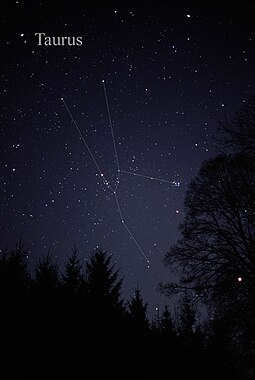
In 1993, a significant discovery was made when long-term variations were detected in the radiation emitted by Aldebaran. This finding was interpreted as evidence of a substellar object located approximately 1.35 astronomical units away from the star. The nature of this object could be either a brown dwarf or a gas giant, with a mass exceeding 11 times that of Jupiter.
Fast forward to 2015, and another exoplanet was found within the Aldebaran system. This newly discovered planet is estimated to be six and a half times the size of Jupiter and completes a full orbit in approximately 700 Earth days. It is believed to be a hot gas giant.
Within the Aldebaran system, there is a second star known as Aldebaran B, which is classified as a dim red dwarf of the M2 type.
Based on the latest data from the Hipparcos satellite in 1989, the distance from the Aldebaran system to the Sun is calculated to be 65.1 light-years.
Comparing the brightness of stars
One of the key characteristics that sets stars apart is their luminosity. Luminosity refers to the amount of radiation that a star emits into space. To provide an example, we can compare the luminosity of Aldebaran, Regulus, Sirius, and the Sun. Aldebaran has a luminosity of 153L, Regulus has a luminosity of 288L, Sirius has a luminosity of 22L, and the Sun has a luminosity of 1L. In this case, L is the unit of energy released by the Sun, which astronomers use as a reference point.
When and How to Observe
The optimal time to observe the star Aldebaran is during the winter season. Locating the star is relatively straightforward. Simply visualize a line passing through the three bright stars that form Orion’s belt, from left to right. If you continue along this line, you will come across Aldebaran as the first star. Additionally, in the Taurus constellation, you can also witness a dispersed cluster of stars known as the Hyades. However, it is important to note that despite their apparent proximity, the Hyades are actually situated 150 light-years away from Earth, which is approximately two and a half times further. The Bull’s Eye effect is merely a result of Aldebaran’s projection onto their luminosity.

Fascinating information

Kievyan Street, 16 0016 Armenia, Yerevan +374 11 233 255


If we were to embark on a journey to the furthest reaches of the Universe, we would encounter celestial entities of immense proportions, so vast that our human minds can scarcely fathom them.
And among the largest entities visible to us at present, excluding nebulae and black holes (which are beyond our visual range), are unquestionably the stars. These colossal luminous orbs that populate the heavens form the foundation for the existence of planets.
And for us, the Sun is the most significant celestial body. We are aware that it possesses an immense size. In fact, it has the capacity to accommodate 1,300,000 Earths. It is truly astonishing. However, the magnitude of this astonishment grows even further when we acknowledge that the Sun, in comparison, is considered a relatively small star.
New stars come to our attention on an annual basis, and although we are currently limited to studying the stars within our own galaxy, the Milky Way (which is one of billions within the universe), we have already encountered stars that are thousands of times larger than the Sun. Therefore, in today’s article, we shall embark on a journey through our galaxy in search of the ten most massive stars.
What is the definition of a star?
Before we delve into our main topic, it’s important to first understand the precise definition of a star. In general terms, a star can be described as a massive celestial body composed of hot plasma that emits light on its own.
To put it differently, a star can be likened to a colossal nuclear reactor, as these spheres of gas and plasma (a state of matter similar to a gas but with some liquid characteristics) contain vast amounts of various elements, with hydrogen being particularly abundant. Within the core of a star, a process known as nuclear fusion occurs, where two hydrogen atoms combine to form helium.
Stars come in various sizes, but they invariably possess a spherical form due to the equilibrium of forces. This means that while the immense gravitational pull causes the star to collapse inward, the nuclear energy produced in its core counteracts this collapse. However, when a star exhausts its hydrogen fuel for fusion, it succumbs to its own gravity and undergoes a collapse. This marks the end of its life, leaving behind a black hole as its remnants. It’s important to note that this phenomenon only occurs with massive stars.
What are the biggest stars in the galaxy?
The number of stars in our galaxy is estimated to be around 100 billion. This astonishing number is even more impressive when we consider that the Milky Way is just one of the 100 billion galaxies believed to exist in the universe.
Therefore, considering that we have only observed stars in our galaxy (and have not yet discovered all of them) and that we have already found gigantic stars like the ones we will discover in the future, what lies ahead?
Let’s embark on our adventure. The stars are organized in ascending order of magnitude. For each star, we have provided its diameter in kilometers. And to help us grasp the scale, let’s compare it to something familiar: The Sun has a diameter of 1,400,000 kilometers. and as we previously mentioned, over a million Earths could fit inside. So get ready to uncover mind-bogglingly massive stars.
10. Pollux: 12,000,000 kilometers.
Pollux is positioned in the constellation Gemini and is classified as an orange giant-type star. Although it ranks as the tenth item on the roster, we are discussing a celestial body that is around ten times larger than the Sun in terms of size. Additionally, it holds the seventeenth spot in terms of brightness among the stars visible to the naked eye. In astronomical terms, Pollux is located at a distance of 33.7 light years from Earth, making it the nearest star to our planet on this list.

The star Pollux. Our Sun, a small orange star, is located on the left.
9. Arturo: 36,000,000 kilometers.
We continue our journey with the star Arthur, which is also known as Arcturus. This particular star, the third brightest in the night sky, is a red giant. Unlike the previous star, it is the closest to us, being only 36.7 light years away. Due to its size, it is believed to be undergoing a fusion process, specifically converting helium into carbon. It is a well-known fact that all chemical elements originate from within stars, and the process requires increasing amounts of energy as the elements become heavier. Our Sun, being relatively small, can only reach the second element, helium.

The star Arthur (also referred to as Arcturus). Pollux is situated on his left side.
8. Aldebaran: 61,000,000 km.
Aldebaran, a star located in the Taurus constellation and ranking as the thirteenth brightest in the night sky, is classified as an orange giant. What’s remarkable is that, despite being nearly 60 times larger than the Sun, it doesn’t even possess twice the mass of our star. This implies that it has undergone various stages in its lifecycle, producing carbon, oxygen, and nitrogen, and currently, it’s in the expansion phase, indicating that it’s getting closer to transforming into a red giant, similar to the ones described below. Its distance from Earth is approximately 65 light years.
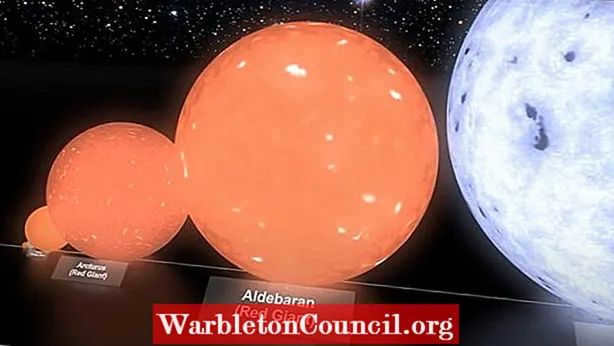
The star Aldebaran is located to the left of Arturo.
7. Rigel: 97,000,000 kilometers.
We have already reached an incredibly large size. Rigel is a blue supergiant that is situated approximately 860 light years away from Earth. It is the brightest star in the Orion constellation and it is so massive that if we were to place it in our solar system, it would extend all the way to Mercury. Rigel is nearing the end of its life and it is predicted that in a few million years, the star will undergo a supernova explosion.
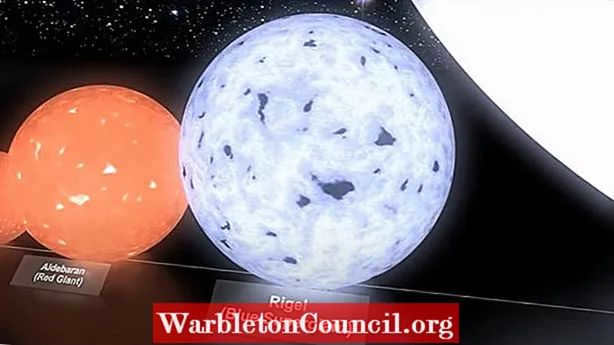
The star Rigel. Aldebaran can be seen to the left of Rigel.
6. Gun Star: 425,000,000,000 kilometers.
We are witnessing an extraordinary increase in size. A gun star, classified as a blue hypergiant, would extend to the orbit of Mars if placed in our solar system. In simpler terms, it would engulf us. This star can shine with the brightness of up to 10 million suns, making it one of the most luminous stars in our galaxy. It is located approximately 26,000 light years away, close to the galactic center.

A firearm star. Rigel is the small star to your left.
5. Antares A: 946,000,000,000 kilometers.
We magnified the previous one twice and discovered Antares A, a red supergiant located 550 light-years away. The most remarkable aspect, apart from its enormous size, is that it is believed to be on the brink of exploding, resulting in a neutron star (one of the densest objects in the universe) as a remnant. There is even the possibility of it becoming a black hole.

The star Antares A. On the left of Antares A, we can observe the Pistol Star.
4. Betelgeuse: 1,300,000,000 kilometers.
Can you imagine a star that would stretch almost to the orbit of Jupiter if it were at the center of our solar system? That is the case with Betelgeuse, the impressive giant of our galaxy. This red supergiant, positioned approximately 642 light-years away, ranks as the ninth brightest star in the night sky. Due to its massive size and relatively cool surface temperature, it is predicted that it will undergo a supernova explosion in a few thousand years, leaving behind a celestial trail that could rival the moon in size. However, the exact timing of this event is a subject of ongoing debate.

The massive star Betelgeuse. Rigel appears as a minuscule speck on the left.
3. Mu Cephei: 1,753,000,000,000 kilometers distant.
Mu Cephei is a red supergiant situated approximately 6,000 light-years away. It is of such immense size that if we were to place it at the heart of our solar system, it would nearly extend to the orbit of Saturn. It is located in the constellation of Cepheus and displays an incredibly vivid red hue, which can even be observed using low-cost telescopes.

The star Mu Cephei. Antares A can be seen on its left.
2. VY Canis Majoris: 2,000,000,000,000,000 kilometers.
VY Canis Majoris has long been recognized as the largest known star. This red hypergiant is located approximately 3,840 light-years away and is so immense that if it were placed at the center of our solar system, it would surpass the orbit of Saturn.

Canis Majoris can be seen on the right side, while the star Betelgeuse is on the left side.
1. UY Scuti: 2,400,000,000 kilometers.
To complete the list, we have the current largest star in our galaxy, UY Scuti. This massive star is located approximately 9,500 light years away. It is so immense that if you were to travel around its surface, it would take nearly 3,000 years to fly non-stop at a speed of 900 km/h. The scale of its size is truly astounding.
Its enormity is such that different metals can be found forming in its core. It is highly probable that its life will eventually culminate in a supernova explosion, leaving behind a black hole.
Do not confuse Aldebaran with Alderamin or Alderaan. If you are looking for other meanings of Aldebaran, click here. This page is about Alpha Tauri. If you are looking for information about the fashion brand AlphaTauri, click here. If you are looking for information about the Formula One racing team, Scuderia AlphaTauri, click here. Scuderia AlphaTauri.
Aldebaran can be found in the constellation Taurus.
Alpha Tau, α Tau, 87 Taurus, BD +16° 629, GJ 171.1, 9159, HD 29139, HIP 21421, HR 1457, SAO 94027
Aldebaran / æ l d ɛ b ər ə n /, also known as Alpha of Taurus, is a massive star located approximately 65 light-years away from our Sun in the constellation Taurus. It serves as the brightest star in Taurus and is typically the fourteenth brightest star visible in the night sky. However, its brightness gradually fluctuates between 0.75 and 0.95. Aldebaran is believed to have a planet called Aldebaran b, which is several times larger than Jupiter.
Aldebaran has a cooler surface temperature of 3900 K compared to the Sun, but its radius is approximately 44 times greater than that of the Sun, making it over 400 times brighter. It rotates at a slow pace, completing a full revolution every 520 days.
The Pioneer 10 space probe is currently traveling towards Aldebaran and is expected to reach the star in approximately two million years.
Nomenclature
The traditional name Aldebaran originates from the Arabic term al Dabarān ("الدبران"), meaning “follower” because it appears to follow the Pleiades. In 2016, the Working Group on Star Names (WGSN) of the International Astronomical Union officially designated it as Aldebaran.
Aldebaran is recognized as the brightest star in the Taurus constellation and is referred to as Alpha Taurus in the Bayer designation. It is designated as Flemstid 87 Taurus, denoting its position as the 87th brightest star in the constellation with a magnitude of 7 or higher, based on its right ascension. Scientific publications also include its identification as star catalog number 1457, HD 29139, and Hipparcos catalog number 21421.
Aldebaran and a number of neighboring stars are listed in various double star catalogs, such as the Washington Double Star Catalog (WDS 04359 + 1631) and the Aitken Double Star Catalog (ADS 3321). It was also listed as a double star in the Herschel Double Star Catalog (H IV 66) with an 11th magnitude companion, in the Struve Double Star Catalog (Σ II 2), and in the Burnham Double Star Catalog (β 550) with a 14th magnitude star.
Observation
Noticing
Observing
Perceiving
Spotting
Detection
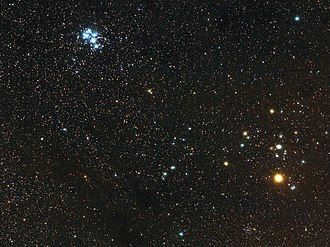
Aldebaran is a star that can be easily observed in the night sky for several reasons. Firstly, it is very bright, making it stand out among other stars. Additionally, it is located near one of the most prominent asterisms in the sky. If you follow the three stars of Orion’s belt in the opposite direction of Sirius, you will come across Aldebaran as the first bright star.
This star is interesting because it appears to be the brightest member of an open cluster called the Hyades. However, this is only because it is in the line of sight between Earth and the Hyades. In reality, the cluster is actually more than twice as far away, approximately 150 light years from Earth. The Hyades cluster forms a bull’s head shaped asterism in the sky.
Aldebaran, which is located 5.47 degrees south of the ecliptic, can sometimes be hidden from view by the Moon. This happens when the Moon’s ascending node is close to the fall equinox. A total of 49 eclipses occurred between January 29, 2015 and September 3, 2018, with each one being visible from locations in the northern hemisphere or near the equator. However, people in Australia or South Africa, for instance, will never have the opportunity to witness the Aldebaran eclipse due to its southern position relative to the ecliptic. During the eclipse on September 22, 1978, a relatively accurate estimate of Aldebaran’s diameter was obtained. Additionally, Aldebaran aligns with the Sun around June 1 of every year.
At a near-infrared J band value of -2.1, Aldebaran is only surpassed in brightness at this wavelength by Betelgeuse (-2.9), R. Doradus (-2.6), and Arcturus (-2.2).
History of Observation
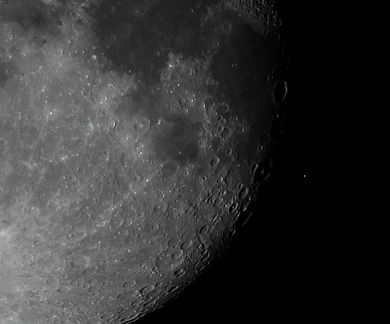
On the 11th of March in the year 509 AD, the people of Athens, Greece witnessed a lunar eclipse involving the star Aldebaran. This celestial event caught the attention of the English astronomer, Edmund Halley, who carefully studied its timing. After analyzing the data, Halley made an intriguing discovery – Aldebaran had shifted its position since that time, moving a few angular minutes further north. This finding, combined with observations of other stars like Sirius and Arcturus, led to the realization that Aldebaran was in motion.
Based on modern observations, it has been determined that Aldebaran has shifted its position by 7 feet over the course of the past 2000 years. To put this into perspective, that’s roughly equivalent to a quarter of the diameter of the full moon. This shift in position is attributed to the phenomenon known as the precession of the equinoxes, which occurred approximately 5000 years ago. Interestingly, during that time, the point of the vernal equinox was in close proximity to Aldebaran.
In 1864, William Huggins conducted groundbreaking research at his personal observatory in Tulse Hill, England. He was able to analyze the spectrum of Aldebaran and identify the presence of various elements, including iron, sodium, calcium, and magnesium. This marked the first-ever study of Aldebaran’s spectrum.
Another significant advancement took place in 1886 at the Harvard College Observatory. Edward C. Pickering utilized a photographic plate to capture the spectrum of Aldebaran, recording a total of fifty absorption lines. These findings were subsequently included in the renowned Draper Catalog, which was published in 1890.
By 1887, photographic techniques had improved significantly, allowing for the measurement of a star’s radial velocity based on the magnitude of the Doppler shift in its spectrum. Using measurements obtained at the Potsdam Observatory by Hermann C. Vogel and his assistants, Yu and Julius Scheiner, it was estimated that Aldebaran had a recession velocity of 30 miles per second (48 km/s).
In 1921, the angular diameter of Aldebaran was measured using an interferometer attached to the Hooker telescope at Mount Wilson Observatory. However, these observations did not result in its resolution.
Due to its extensive observational history, Aldebaran was selected as one of the 33 stars for the Gaia mission to serve as a reference point in calibrating the derived stellar parameters. Furthermore, it has also been employed in the calibration of instruments on board the Hubble Space Telescope.
Physical attributes
Aldebaran is classified as the standard for stars of type K5 + III in terms of its spectral properties. Its spectrum indicates that it is a giant star that has evolved from the main-sequence band of the Hertzsprung-Russell diagram after depleting the hydrogen in its core. The collapse of the star’s center into a degenerate helium core sparked a hydrogen shell outside the core, and Aldebaran is now situated on the red giant branch (RGB).
Aldebaran’s photospheres have an effective temperature of 3910 K. It possesses a surface gravity of 1.59 cgs, which is characteristic of a giant star, but around 25 times lower than that of Earth and 700 times lower than that of the Sun. Its metallicity is approximately 30% less than that of the Sun.
Based on data from the Hipparcos satellite and other sources, it has been determined that Aldebaran is located 65.3 light-years away, which is equivalent to 20 parsecs. Through the use of asteroseismology, scientists have also discovered that Aldebaran is about 16% more massive than the Sun. However, due to its larger radius, its luminosity is 518 times that of the Sun. Numerous measurements have been conducted to determine Aldebaran’s angular diameter. The value that has been adopted as part of the Gaia benchmark calibration is 20.580 ± 0.030 ms. This measurement is 44 times the diameter of the Sun, which is approximately 61 million kilometers.
Aldebaran is categorized as a slow irregular variable star, denoted as LB in the General Catalog of Variable Stars. According to historical records, there have been reported differences in its apparent magnitude ranging from 0.75 to 0.95. However, more recent studies have shown a smaller amplitude and some even suggest minimal change. Based on Hipparcos photometry, the amplitude is estimated to be only around 0.02 stellar magnitude with a potential period of approximately 18 days. In-depth ground-based photometry has revealed variations of up to 0.03 magnitude and a potential period of about 91 days. Nevertheless, a comprehensive analysis of observations spanning a longer time frame indicates that the overall amplitude is likely to be less than 0.1 stellar magnitude, and the variability is considered to be irregular.
The photosphere of Aldebaran indicates that the star has reached its first phase of becoming a red giant, known as the upward dredge stage. During this stage, materials from the inner layers of the star are brought to the surface through convection. However, due to its slow rotation, Aldebaran does not have a strong enough magnetic field to generate a corona and emit hard X-ray radiation. Nevertheless, there may still be small-scale magnetic fields near the surface caused by convection turbulence. The measured magnetic field strength on Aldebaran is 0.22 Gauss. Any soft X-ray emission from this region may be weakened by the chromosphere, although ultraviolet emission has been observed. Aldebaran is currently losing mass at a rate of (1-1.6) × 10 -11 M ⊙ year -1, which is equivalent to about one Earth mass every 300,000 years. This mass loss is likely due to weak magnetic fields in the lower atmosphere.
Aldebaran’s chromosphere is surrounded by the extended molecular outer atmosphere (MOLsphere), where gas molecules can form due to its low temperature. This region has a radius that is approximately 2.5 times that of the star and a temperature of approximately 1500 K. The spectrum of this region displays lines that correspond to carbon monoxide, water, and titanium oxide. Moving beyond the MOLsphere, the stellar wind continues to expand until it encounters the hot ionized interstellar medium, which dominates the Local Bubble. At this point, a shock boundary is formed, creating a roughly spherical astrosphere with a radius of around 1000 a.u. This astrosphere is centered on Aldebaran.
Companions in Sight
Aldebaran is accompanied by a cluster of five faint stars in the night sky. These stars are part of a binary system and have been designated with capital letters of the Latin alphabet, roughly in the sequence of their identification, except for the host star which is labeled as A. The table presents an outline of various attributes of these stars, such as their location in relation to Aldebaran.
According to the Gaia Data Release 2, it has been discovered that Alpha Taurus B potentially shares the same proper motion and parallax as Aldebaran, suggesting that they may form a physical binary system. However, due to the close proximity of the dim B component to the bright host star, it is challenging to accurately measure and determine whether there is a physical connection between the two. At present, there is no definitive evidence to confirm or reject the association of the B component or any other object with Aldebaran. The B component has been classified as a spectral class M2.5.
Alpha Tauri CD is a binary system in which the stellar components C and D are gravitationally linked and circling each other. These stars, revolving in the same trajectory, have been proven to be located significantly farther from Aldebaran and belong to the Hyades star cluster. Similar to the rest of the stars within the cluster, they lack any physical interaction with Aldebaran.
System of celestial bodies
In the year 1993, the radial velocity of Aldebaran, Arcturus, and Pollux was measured and it was discovered that Aldebaran displays long-period fluctuations in radial velocity that could possibly be attributed to a celestial body of lower mass. The measurements assumed that Aldebaran has a companion with a minimum mass of 11.4 times that of Jupiter, orbiting at a distance of 2.0 a.u. (300 Gm) in a slightly elliptical orbit with a duration of 643 days. Interestingly, all three stars observed exhibited similar oscillations, resulting in comparable companion masses. As a result, the researchers concluded that the observed changes were likely intrinsic to the star itself, rather than being caused by the gravitational effects of a companion.
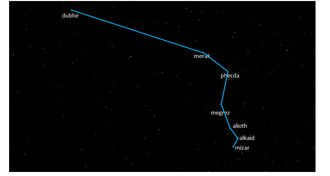
In 2015, a research study provided strong and consistent evidence for the existence of both a planetary companion and stellar activity. Through the analysis of the remnants found on the planet’s surface, it was determined that Aldebaran b has a minimum mass of 5.8 ± 0.7 times that of Jupiter. Furthermore, when the star was in its main sequence, it emitted light levels similar to those of Earth, indicating potentially habitable temperatures. As a result, both the planet and its satellites are believed to have been located in the habitable zone. However, a subsequent study conducted in 2019 found inconclusive evidence regarding the existence of planets in this system.
Origin and Legend
The original name of Aldebaran was نير الضبران (Nā᾽ir al Dabarān in Arabic), which translates to “bright of the follower”. The term Al-Dabarān (الدبران) was later used to refer to the entire lunar mansion that includes the Hyades. It is believed that Aldebaran was watching over the Pleiades. There are various transliterations of the name, but the current standard is Aldebaran.
Mythology
This star, easily identifiable due to its striking asterism, has been a popular topic in both ancient and modern myths.
- Mexican culture: In the northwestern region of Mexico, this star is believed to provide light to seven birthing women, known as the Pleiades. It is referred to by three names: Hant Caalajc Ipápjö, Queeto, and Azoj Yeen oo Caap (“the star that goes before”). The lunar month corresponding to October is called Queeto yaao, which translates to “the way of Aldebaran.”
- Aboriginal culture: In the Clarence River in northeastern New South Wales, this star is considered to be the ancestor of the Carambal, who stole another man’s wife. The woman’s husband eventually found him and set fire to the tree he was hiding in. It is believed that he ascended into the sky as smoke and transformed into the star Aldebaran.
Names in different languages
- In Hindu astronomy, it is known as the lunar mansion of Rohini (“red”) and as one of the twenty-seven daughters of Daksha and the wife of the god Chandra (Moon).
- In ancient Greek it was referred to as Λαμπαδίας Lampadias, which means “torch, like a torchbearer.”
- In Chinese, 畢宿 (B.I. Xiu) represents a group of stars, including Aldebaran, e Taurus, δ 3 Taurus, δ 1 Taurus, γ Taurus, 71 Taurus, and λ Taurus. Therefore, the Chinese name for Aldebaran itself is 畢宿五 (Bì Xiù wǔ), which means “The Fifth Star of the Net.”
In modern society.

There have been numerous instances where the name Aldebaran or Alpha Tauri has been utilized:
- Aldebaran Rock in Antarctica
- A U.S. Navy ship called USS Aldebaran (AF-10) and the Italian frigate Aldebaran (F 590)
- The proposed Aldebaran microsatellite launch vehicle
- The French company Aldebaran Robotics
- The fashion brand AlphaTauri
- The Formula 1 team Scuderia AlphaTauri, previously known as Toro Rosso
The star is also featured in works of fiction such as ” Away from the madding crowd” (1874) and ” Down and out in Paris and London” (1933). It is frequently depicted in science fiction, including in the TV series The Lensman (1948-1954) and ” Fallen Dragon” (2001). As the most brilliant star in the constellation of the Zodiac, it holds significant importance in astrology.
Aldebaran is often mentioned in conspiracy theories as one of the origins of extraterrestrial visitors, frequently linked to Nazi UFOs. A notable example is German conspiracy theorist Axel Stoll, who believed the star to be the homeland of the Aryan race and the target of Wehrmacht expeditions.

